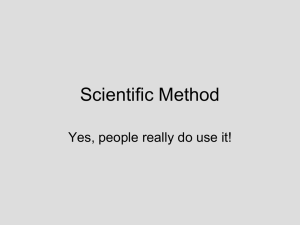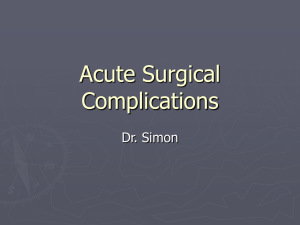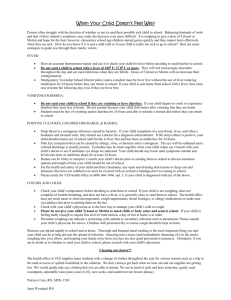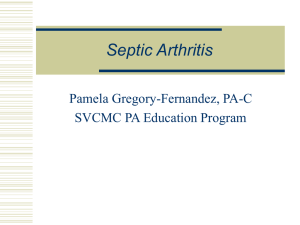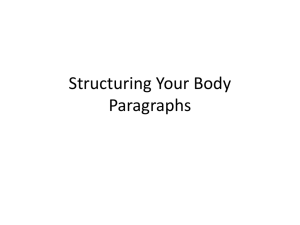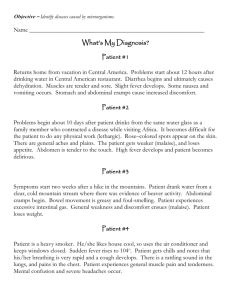Brief Summary of Common English Usage Errors In Case Reports:
advertisement
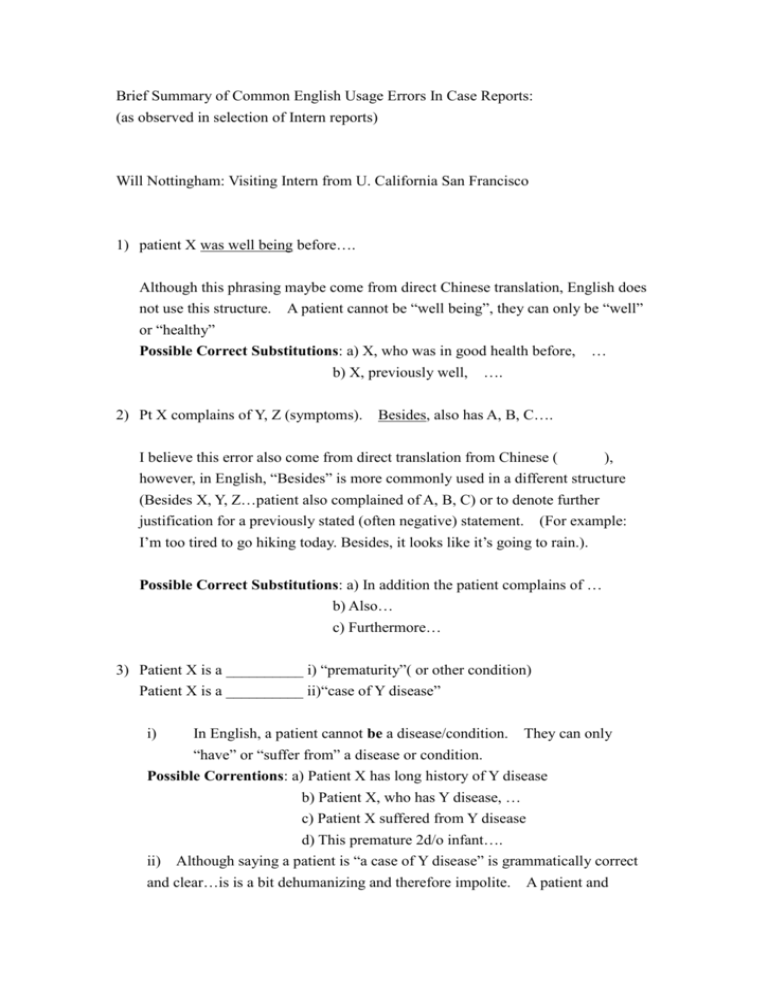
Brief Summary of Common English Usage Errors In Case Reports: (as observed in selection of Intern reports) Will Nottingham: Visiting Intern from U. California San Francisco 1) patient X was well being before…. Although this phrasing maybe come from direct Chinese translation, English does not use this structure. A patient cannot be “well being”, they can only be “well” or “healthy” Possible Correct Substitutions: a) X, who was in good health before, b) X, previously well, …. 2) Pt X complains of Y, Z (symptoms). … Besides, also has A, B, C…. I believe this error also come from direct translation from Chinese ( ), however, in English, “Besides” is more commonly used in a different structure (Besides X, Y, Z…patient also complained of A, B, C) or to denote further justification for a previously stated (often negative) statement. (For example: I’m too tired to go hiking today. Besides, it looks like it’s going to rain.). Possible Correct Substitutions: a) In addition the patient complains of … b) Also… c) Furthermore… 3) Patient X is a __________ i) “prematurity”( or other condition) Patient X is a __________ ii)“case of Y disease” i) In English, a patient cannot be a disease/condition. “have” or “suffer from” a disease or condition. They can only Possible Correntions: a) Patient X has long history of Y disease b) Patient X, who has Y disease, … c) Patient X suffered from Y disease d) This premature 2d/o infant…. ii) Although saying a patient is “a case of Y disease” is grammatically correct and clear…is is a bit dehumanizing and therefore impolite. A patient and human being is much more than his/her disease or condition. Therefore, the most gracious and polite way of referring to a patient w/ a certain disease denotes this subtle difference. This helps keep focus on patient as a human being…not just a disease case, envoking more compassion and sensitivity in physician. Possible Changes: a) This patient has Y disease b) This young woman suffers from Y. c) This 6 y/o child is treated for Z disease. 4) ….fever struck…. Although this phase is clear and informative, I have never seen this phrase in American medical charts. We more commonly say patient “had” or “has” a fever, “is” or “was” febrile, or sometimes, usually in oral presentations, we say a patient “spiked” a fever to X degrees. Possible Changes: a) Last night, patient spiked a fever to 39 degrees Celsius. b) This afternoon, the patient had a fever of 39…. c) Overnight, patient’s temperature reached 39….. d) Mother reports the patient had a fever of 39 Celsius… e) The patient has been febrile for 10 days. f) Although the patient was febrile yesterday, today the ( i: patient is afebrile. ii: fever broke iii: fever subsided and so on…) 5) “ was given OPD treatment but in vane…” “in vane” is clear, but it’s usage is strange here. “In vane” is an expression reserved for dramatic situations, and not commonly used in American medical charts (It’s possible this usage comes from British, but I’m not sure) Possible Changes: a) …but without effect b)…but without resolution of symptoms (or illness) c) …but without improvement. 6) “ patient X had a regular vaccination schedule…” This phrase literarly means that the patient had vaccinations at regular intervals over time… however, in a medical chart it usually should mean that the patient has had all the appropriate childhood vaccinations at the appropriate times. To make the English meaning clear, different phrasing should be used. Possible Corrections: a) vaccinations are current b) vaccinations are up to date. c) has had all vaccinations as scheduled. 7) Common errors in Physical exam write-up: i. ii. iii. PE should always start with General impression (same, improved, looks tired, etc.) and VITALS. Many reports did not include vital signs or General impression. This is of key importance as it gives reader an immediate impression of whether to patient is stable or not.. Fever: fever is objective, NOT subjective…but many reports of fever were placed in subjective portion of SOAP note. A patients subjective feeling of being hot “patient felt hot this morning” or “patient thinks they might have had fever overnight” may go in subjective portion….but a physical recording of fever ALWAYS goes in Objective (last night at 11pm patient had recorded temperature of 40 Celsius) Breath sounds: too often if sounds are abnormal, they are only recorded as “COARSE”. Course is a very nonspecific description, and not especially helpful in patient care. Students should try to further describe breath sounds (Rales? Crackles? Wheezes? Decreased or distant breath sounds)…which more directly relate to possible pathology. It the student does not know how to describe the sounds…should ask resident or VS. “Course” is a bit lazy description. 8) General: Verb Tenses. I realize this is a difficult part of English, but there were commonly errors in verb conjugation.


